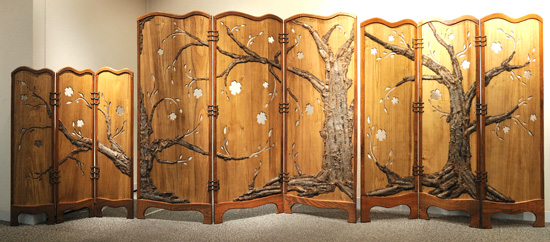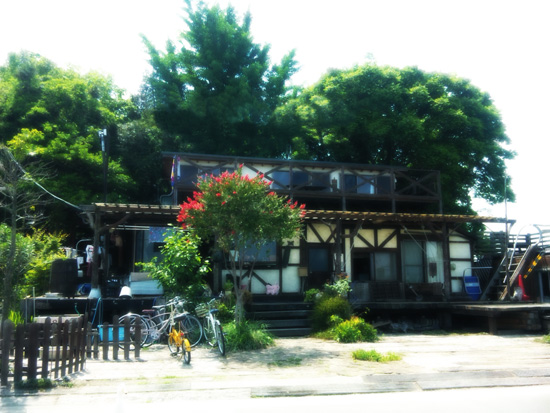What’s Our Studio


日本には、春夏秋冬、四季の美しさを愛でる文化があるとともに、
台風、地震、津波という恐ろしい自然災害があります。
この数年、大きな地震により、日本は2度も壊滅的な地震災害に見舞われました。
「廃材家具・工房エンジェルのために」は、「木」の魂を受け継ぐファクトリーとして誕生しました。
誕生のきっかけは、神戸で発生した阪神淡路大震災。死者5千人以上、倒壊家屋10万棟を超えた大災害です。
発生した沢山の瓦礫の撤去にともない、それまでそこに住まう人々の暮らしを見つめ、
育んできた大量の柱や梁が、廃材として捨てられ、燃やされていました。
この廃材が処分されるのを目の当たりにした庸(Yoh)とRickyが気づいたのが
「この廃材を材料にして、家具をつくる」ということです。
こうして1995年以来、廃棄される木材に新しい生命を吹き込む工房が誕生したのです。


The Japanese have a deep appreciation for the four seasons.
At the same time, the country is subject to frequent natural disasters like typhoons, earthquakes, and tsunamis.
In recent years, Japan has twice suffered from devastating earthquakes.
The “Scrap Wood Furniture Factory For an Angel” was established to carry on the spirit of the forest.
Its origins go back to the Hanshin-Awaji Earthquake of 1995, a disaster that claimed more than 5,000 lives and destroyed 10,000 homes.
“We saw the roof tiles and rubble being cleared away from what were once homes where people lived. We say posts and beams, which once supported these homes, being discarded and burned.”
As Yoh and Ricky Nagashima saw this scrap wood being taken away, they suddenly thought, “Why not use this waste as wood for making furniture?!”
Thus began a woodworking studio where discarded wood is given a second life as beautiful, unique furniture.
I giapponesi hanno un profondo apprezzamento per le quattro stagioni.
Allo stesso tempo, il paese è soggetto a frequenti disastri naturali come tifoni, terremoti etsunami.
Negli ultimi anni, il Giappone ha sofferto per due volte da terremoti devastanti.
La “Fabbrica Scrap Legno Mobili Per un angelo” è stato istituito per portare avanti lo spirito della foresta.
Le sue origini risalgono al terremoto Hanshin-Awaji del 1995, un disastro che ha causatopiù di 5.000 vite e distrutto 10.000 case.
“Abbiamo visto le tegole e calcinacci di essere spazzati via da ciò che una volta eranocase dove la gente viveva. Diciamo pali e travi, che una volta sostenuto queste case, di essere scartato e bruciato”.
Come Yoh e Ricky Nagashima visto questo legno di scarto di essere portato via,improvvisamente pensato: “Perché non utilizzare questo tipo di rifiuti come legno per mobili?”
Inizia così uno studio del legno in cui è dato in legno scartato una seconda vita così bella,mobili unici.

ヨーロッパの「石の家」に比べて、日本の「木と土と紙の家」があります。
ローマや古代ギリシャは、永久の文化を願って強固な石の建造物を営々と建ててきました。
日本にも縄文時代の巨石文明から、城壁・護岸など石の利用にも優れた技術があります。
それがなぜかその後の建築・造形の主流にならなかったのは、やはり「木」に対する愛着と、
日本という湿度と四季の温度差への適応に「木」が向いているからだと言われています。

Europeans live in stone houses.
In Japan, traditional homes are made of wood, earth, and paper.
The ancient Romans and Greeks created buildings out of stone in the hope that their culture would live on for eternity.
Japan also boasts a history of advanced stonework techniques, beginning with the massive rocks used to build the civilization of the prehistoric Jomon Period, and continuing to the castle walls and ocean embankments of the Middle Ages.
So why didn’t stone become Japan’s material of choice for architecture? We believe it is because of the Japanese people’s love of wood; how wood can adapt to the country’s humidity and the changing temperatures of the four seasons.
Gli europei vivono in case di pietra.
In Giappone, case tradizionali sono realizzati in legno, terra, e carta.
Gli antichi Romani e Greci realizzato edifici in pietra, nella speranza che la loro culturaavrebbe continuato a vivere per l’eternità.
Giappone, vanta anche una storia delle tecniche avanzate in pietra, a cominciare con le rocce massicce utilizzati per costruire la civiltà del periodo preistorico Jomon, e continuando a le mura castellane e argini oceanici del Medioevo.
Allora perché non in pietra diventano materiale del Giappone di scelta per l’architettura?Crediamo che sia per amore del popolo giapponese di legno, come il legno in grado di adattarsi all’umidità del paese e le temperature mutevoli delle quattro stagioni.

「木、土、紙」と日本人との関わりは、「森の文化」
日本人の心の拠り所は、自然の山であり森や林であり、それとの「繫がり」をより深くしていく思想があります。
たとえば家を建てるとき「地鎮祭」を行なって土地の神に許しを得、工事の無事を祈り、
「建前式(柱建て行事)」を行なうという、今に残る習慣に強く現れています。
そして、この「木」に対する信仰・思い入れは、日本人の匠の技に結び付き、
日本ならではの「建築文化」を実らせてきました。
The Japanese: Born of the forest and in harmony with its elements of wood, earth, and paper.
The heart and soul of the Japanese reside in nature’s mountains and forests. Deep down, people have a desire to maintain and strengthen their bonds with these elements.
This is apparent in ceremonies related to the construction of a house. Before construction begins, there is a “jichinsai,” a Shinto ceremony to receive the blessings of the god of the earth. As construction nears completion, the “jotoshiki,” or ridgepole-raising ceremony, is held to thank the god for protecting the workers and ensure a safe completion of the house. These customs remain integral to Japan’s house-building culture.
The carpenters and crafts people who build these hours carry on this culture as the embodiment of the faith and emotional connection that japanese people have with wood.
I giapponesi: Nato della foresta e in armonia con i suoi elementi di legno, terra e carta.
Il cuore e l’anima del Giappone risiedono nelle montagne della natura e delle foreste. In fondo, le persone hanno il desiderio di mantenere e rafforzare i loro legami con questi elementi.
Questo è evidente nelle cerimonie relative alla costruzione di una casa. Prima dell’inizio della costruzione, c’è un “jichinsai”, una cerimonia Shinto per ricevere le benedizioni del dio della terra. Come costruzione si avvicina al completamento, il “jotoshiki”, o ridgepoledi sensibilizzazione cerimonia, è tenuto a ringraziare il dio per proteggere i lavoratori e garantire un sicuro il completamento della casa. Queste usanze rimangono parte integrante del Giappone costruzione della casa della cultura.
I falegnami e artigiani che costruiscono queste ore portare avanti questa cultura come l’incarnazione della fede e connessione emotiva che i giapponesi hanno con il legno.

木と土と紙の家、そこに住み続けるには、「手入れ」が必要です。
日本では、家屋を維持するための職人文化が備わっています。
「木の職人」「土の職人」「紙の職人」。
それぞれが技術を磨き、家屋の手入れを行うことで、「家」を守り続けているのです。
But living in a house of wood, earth, and paper requires constant care.
That is the job of artisans.
Wood artisans, earth artisans, and paper artisans?all of them continue to hone their techniques and care for houses as they carry on the proud tradition of protecting Japanese houses.
Ma vivere in una casa di legno, terra, carta e richiede una cura costante.
Questo è il compito degli artigiani.
Artigiani del legno, artigiani della terra, e gli artigiani di carta? Tutti loro continuano ad affinare le loro tecniche e la cura per le case pur di portare avanti la gloriosa tradizione della protegge le case giapponesi.













